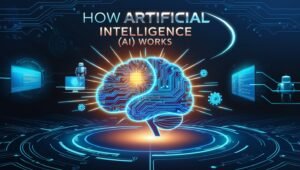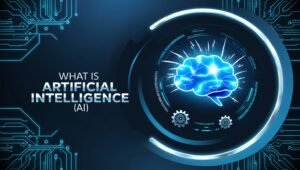What Is Artificial Intelligence (AI)?
AI is a technology that enables computers and machines to imitate human intelligence and creatively solve problems. The best thing about artificial intelligence is its capability to rationalize and then act to attain a certain goal. Artificial Intelligence (AI) became a field of research in the 1950s. In the 1960s, it was employed by the Department of Defense in the United States for its project in which computers were trained to imitate human reasoning.
Key Takeaways
Artificial intelligence or robotic technology makes it possible for a computer or a machine to imitate human intelligence and problem-solving ability.
Algorithms are said to be an integral part of AI systems. A simple algorithm is used in basic applications, while a complex one stands for a strong AI.
Artificial intelligence technology is obvious in computer programs that play chess, in self-driving cars, and in banking systems that can identify cases of fraud.
How Artificial Intelligence (AI) Works

Artificial Intelligence has already been pointed out in the implementation of robots. Technology has developed and paradigms that were considered AI characteristics have become inadequate. Technologies involving Artificial Intelligence are as follows: Artificial intelligence generally perceives a robot in the frame of the robot’s implementation. As technology advanced, the boundaries of machine intelligence that were previously in use became obsolete. Technologies that facilitate Artificial Intelligence include:
- Computer vision is the ability of computers to recognize objects and people in images and pictures.
- Natural language processing (NLP) allows computers to develop the ability of human language understanding.
- Graphical processing units are computer chips that help computers make graphics and images using mathematical calculations.
- The Internet of Things is all the networked physical things with sensors, software, and network connectivity that not only produce data but also do the sharing.
- Application programming is a type of coding that allows two or more computer programs or components to exchange information with each other.
Types of Artificial Intelligence
Narrow AI: Also referred to as Weak AI, this type of system is designed to perform a specific task. Examples of Weak AI include video games and personal assistants like Amazon’s Alexa and Apple’s Siri. Users can ask these assistants questions, and they provide answers.
General AI: This category encompasses strong artificial intelligence systems that can perform tasks that resemble human capabilities. These systems are generally more complex and can be found in applications such as self-driving cars or in the operating rooms of hospitals.
Using Artificial Intelligence
Artificial intelligence has a wide range of applications across various sectors and industries, including healthcare, where it can suggest drug dosages, identify treatments, and assist in surgical procedures in the operating room.
Other examples of artificial intelligence include computers designed to play chess and self-driving vehicles. AI is also utilized in the financial sector, where it identifies and reports suspicious banking activities. AI applications can enhance efficiency and simplify trading processes. In 2022, AI became more mainstream with the rise of Generative Pre-Training Transformers. Notable examples include OpenAI’s DALL-E, a text-to-image generator, and ChatGPT. A 2024 survey by Deloitte revealed that 79% of AI industry leaders anticipate generative AI will significantly change their organizations by 2027. What Is Reactive AI? Reactive AI is a form of Narrow AI that employs algorithms to improve outputs based on specific inputs. For instance, chess-playing AIs are reactive systems that determine the best strategies to win. Reactive AI is generally quite static, lacking the ability to learn or adapt to new situations.
What Are the Concerns Surrounding the Use of AI?

Many people are worried about the impact of artificial intelligence on human jobs. As various industries seek to automate tasks with advanced machinery, there is a fear that workers could be displaced from their positions. For instance, self-driving cars might eliminate the need for taxis and ride-sharing services, while manufacturers could easily substitute human labor with machines, rendering certain skills obsolete.
What Is Reactive AI?
Reactive AI refers to a specific type of Narrow AI that employs algorithms to enhance outputs based on predetermined inputs. A good example of this is chess-playing AIs, which are reactive systems designed to determine the best strategy to win the game. Reactive AI is generally quite static, lacking the ability to learn or adapt to new situations.
What Are the Concerns Surrounding the Use of AI?
Many people are worried about the impact of artificial intelligence on human jobs. As various industries seek to automate tasks with advanced machinery, there is a growing fear that workers could be displaced from their positions. For instance, self-driving cars might eliminate the need for taxis and ride-sharing services, while manufacturers could easily substitute human labor with machines, rendering certain skills obsolete. Trade on the Go. Anywhere, Anytime One of the largest cryptocurrency exchanges in the world is at your service. Experience competitive fees and dedicated customer support while trading securely. You’ll also have access to Binance tools that simplify viewing your trade history, managing auto-investments, analyzing price charts, and making fee-free conversions. Create a free account and join millions of traders and investors in the global crypto market.
